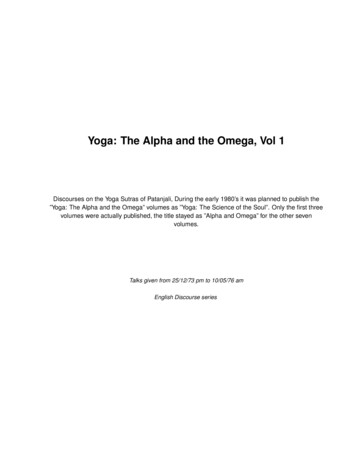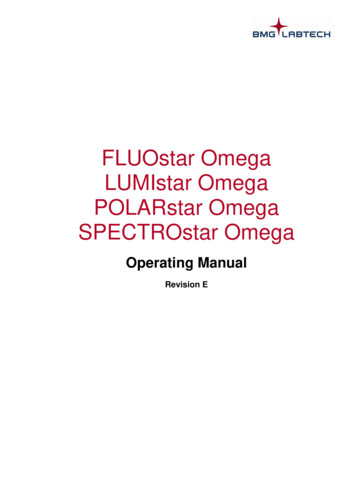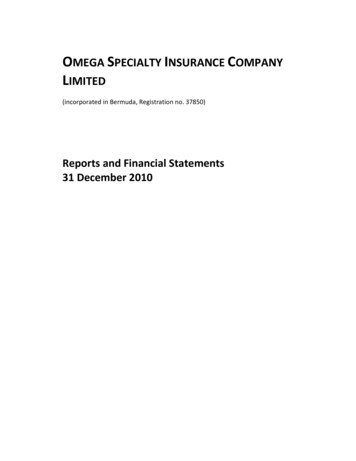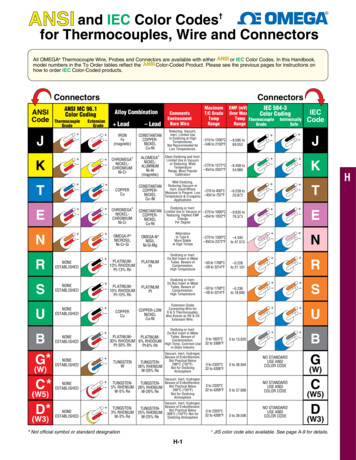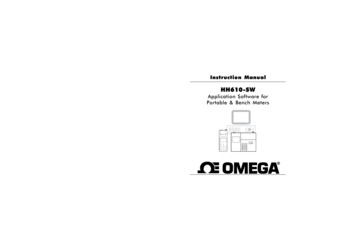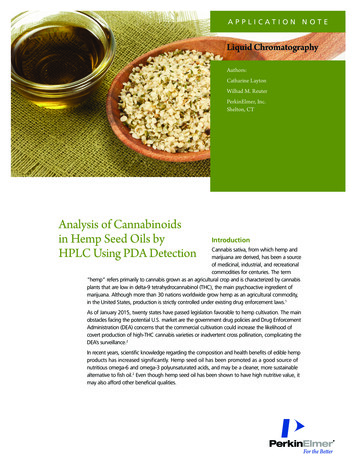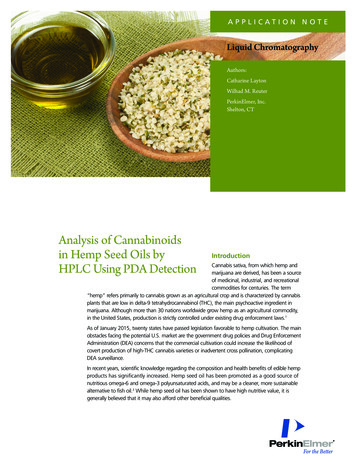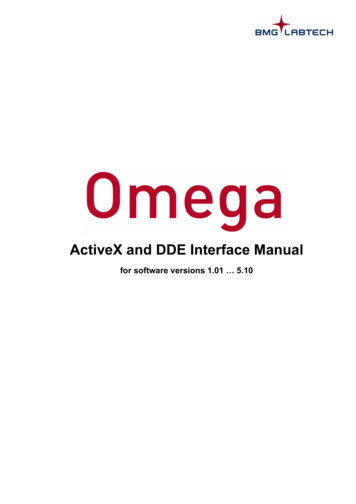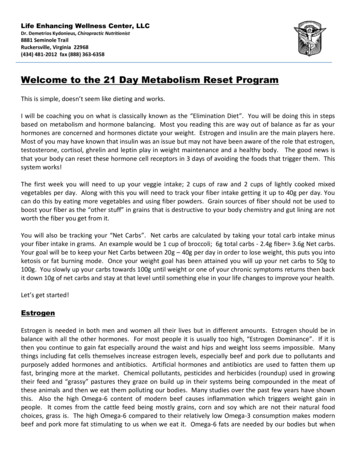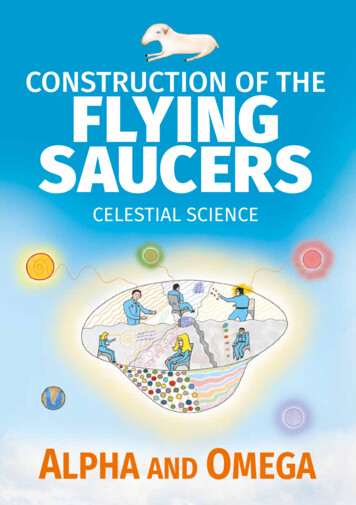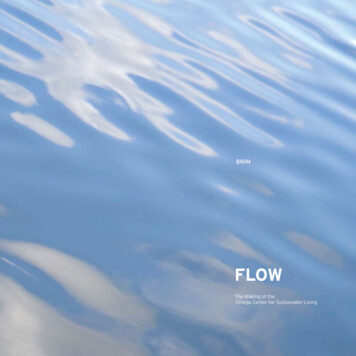
Transcription
BNIMflowThe Making of theOmega Center for Sustainable Living1
23
creditsMany thanks to all those that have made this groundbreaking facility possible,including those noted below as well as donors, patrons and friends of theOmega Institute.BNIMOmega Institute StaffRobert “Skip” Backus, Chief Executive OfficerCarla Goldstein, External Affairs & Women’s Institute DirectorGeorge Kaufman, Resource Development DirectorOmega Institute Board of DirectorsGary Krauthamer, ChairPatty GoodwinNigol KoulajianSheryl LambWalter LinkStephan Rechtschaffen, MD (Cofounder of Omega)Elizabeth Lesser (Cofounder of Omega)David OrlinskyProject TeamArchitect - BNIMCivil Engineer - Chazen CompaniesConstruction – David Sember ConstructionEcological Design - John Todd Ecological DesignLandscape Architect - Conservation Design ForumMechanical/Electrical/Plumbing Engineer - BGR EngineersStructural Engineer – Tipping Mar associatesWater Systems Engineer - Natural Systems InternationalimageryCourtesy of Andi Milford: pages 2-3, 4, 7, 8, 11, 23, 37 / PlanetReuse: page 32 /Tipping Mar associates: pages 28, 29 / Google Earth: pages 16, 17, 18-19 /Omega Institute: page 20 (top right) and page 23 / bnim: all othersflowThe Making of theOmega Center for Sustainable Livingat theOmega Institute for Holistic StudiesRhinebeck, New York
dedicationCongratulations to Skip Backus and the Omega Institute for what you have accomplishedin the Omega Center for Sustainable Living. Not only has this facility helped redefine ourrelationship with water, but it has greatly influenced the larger reconnection of nature andhuman nature. As many in the developing world have sought to dominate nature, this facilitydemonstrates a way of understanding our interdependence with nature, of learning nature’sprinciples and living within them.While this achievement would be remarkable in and of itself, Omega has also embraced thenotion of sustainable design and construction to its fullest. As a leader in the Living Buildingmovement, Skip Backus and his team have furthered the industry’s understanding of truesustainability. As more and more claims to “green” are filling our world, Omega can genuinelybe proud of investing in a facility that has diligently examined every aspect of our builtenvironment – from site selection, water use and energy generation, to material sourcing andselection, construction waste management, beauty and inspiration.In this endeavor, Omega has held true to their vision and has deepened our collectiveunderstanding of our relationship with the natural and spiritual worlds. We at BNIM thank youand consider it an honor to have worked alongside you.5
message from skip backusadapted from the rhinebeck campus guideDear Friends,I like to think historians will look back on this decade and say it was the beginning of a renaissance – a time when theunderstanding of the interdependence of all life became a blueprint for living; a time when individuals, organizations,and cultures around the world woke up and took stock of what really matters.Being optimists at heart, we at Omega Institute look at the crises of our times and we see opportunities for areexamination of human values and ways of living. Since it seems that it’s human nature to make big changes onlywhen confronted with big challenges, we have the chance – now more than ever – to move from an old paradigm ofexploitation to one of sustainability and creativity.How do we do this? How do we resist becoming overwhelmed or pessimistic or frightened? First of all, it helps tosuspend a cynical worldview long enough for a new vision to emerge. We need hope in times of change. We need skillslike flexibility, tolerance and inner strength. And we need each other.At Omega, you will find others with a passion for positive change – people co-creating a more hopeful future througheveryday choices and more mindful ways of relating to each other and the world. Our mission is to be a resource forthat future. For 30 years, we have offered holistic learning experiences with the world’s most qualified and inspiringfaculty – workshops, trainings and conferences that nourish the body, mind and soul, and that honor lifelong learningand personal growth.New in 2009 is the Omega Center for Sustainable Living (ocsl). The center will be the anchor for our environmental effortson campus. It will bring under one roof our state-of-the-art energy and waste systems, our efforts to work with area farmsand organic growers, and a teaching facility that demonstrates local solutions to global problems. So, when you come toOmega, you become part of a growing community of people working together to jumpstart the renaissance!Warmly,Robert “Skip” Backus, Chief Executive Officer
To Everything (Turn, Turn, Turn)There is a season (Turn, Turn, Turn)And a time for every purpose, under HeavenA time to be born, a time to dieA time to plant, a time to reapA time to kill, a time to healA time to laugh, a time to weepTo Everything (Turn, Turn, Turn)There is a season (Turn, Turn, Turn)And a time for every purpose, under HeavenA time to build up, a time to break downA time to dance, a time to mournA time to cast away stones,a time to gather stones togetherTo Everything (Turn, Turn, Turn)There is a season (Turn, Turn, Turn)And a time for every purpose, under HeavenA time of love, a time of hateA time of war, a time of peaceA time you may embrace,a time to refrain from embracingTo Everything (Turn, Turn, Turn)There is a season (Turn, Turn, Turn)And a time for every purpose, under HeavenTurn Turn TurnSong composed by Pete Seeger in 1959. Performed live on October 11, 2007 at the OCSL groundbreaking.A time to gain, a time to loseA time to rend, a time to sewA time to love, a time to hateA time for peace, I swear it’s not too late
About Living BuildingsLiving Buildings are informed byand heavily rooted in the indigenouscharacteristics of a building’s eco-regionin order to renewably generate theirown energy; capture, treat and use theirown water; and operate by embracingthe essence of what the site can provide.In this way, each “Living Building”strives to have a net zero impact.10 Living Building Challenge, a program of the International Living Building Institute, is a certification programThededicated to ensuring that buildings are achieving stringent guidelines in key areas of site, energy, materials, water,indoor quality and beauty and inspiration. Certification is based on actual performance rather than estimatedperformance, therefore a 12-month verification period is required before buildings will be evaluated.
hudson river Watershed“Take care of the land andthe land will take care of you.”– Hugh H. BennettThe Omega Institute issituated within one of the mostimportant watersheds in theworld, the 13,400 square mileHudson River watershed basin.The river is 315 miles long and divided into three sections with the Omega campus lyingwithin the 154-mile lower basin. This basin provides water for over 12 million people throughsurface water, groundwater and a series of reservoirs. It is a critical component of the localand regional ecosystem.Water management at Omega influences water quality for the immediate surroundings ofthe campus as well as the downstream lake and waterways within the watershed, so thatresponsible stewardship here will benefit one of the world’s most populous urban areas.13
life of waterlColectionoCSLR ainteradwunelong lakegro14machinvia wellsm puscaecoinstituteegaomAs the world’s population approachesseven billion, the need for even greateramounts of clean water will grow. Atthe same time, our actions are reducingthe amount of accessible clean water.It is time to change the patterns of thepast, water abuse among them.Water supply on the Omega Campus at Rhinebeck is provided directly from the groundwater via wells on campus.Prior to the construction of the Omega Center for Sustainable Living, water was drawn from the wells, used formultiple human activities, then piped to a septic / leach field system along Lake Drive. The Omega Center’s EcoMachine now returns a higher quality of water back to the earth using natural systems that see our waste as food.For potable water uses, well water is still drawn from the earth. For toilet flushing, rainwater is collected from theOmega Center’s roof. For all other water use on campus, black and grey water is sent to the Eco Machine lagoonsand constructed wetlands at the Omega Center for purification. Within the Omega Center building, and throughoutthe campus, low-flow plumbing fixtures have been installed to minimize water consumption, including waterlessurinals in the men’s restroom. By the end of this cycle that uses natural systems, cleaner water is reintroduced tothe groundwater and lake.
contextEarthAtlantic SeaboardHudson River Valley16Omega Institute of Sustainable LivingOmega Institute Campus and Environs
Regional
history of omegaOmega was founded in 1977 at a time when holistic health, psychological inquiry, world musicand art, meditation, and new forms of spiritual practice were just budding in American culture.The mission was as simple as it was large:To look everywhere for the mosteffective strategies and inspiringtraditions that might help peoplebring more meaning and vitalityinto their lives.Since then, Omega has become the nation’s largest holistic learning center. Every year morethan 20,000 people attend workshops, retreats, and conferences on its 195-acre campus inthe countryside of Rhinebeck, New York, and at other sites around the country.While Omega has grown, the mission remains the same. Omega is not aligned with anyparticular healing method or spiritual tradition. The programs feature all of the world’swisdom traditions and are committed to offering people an opportunity to explore their ownpath to better health, personal growth, and inner peace.The name “Omega” was inspired by the writings of Teilhard de Chardin, a 20th-centurymystic and philosopher who used the word “Omega” to describe the point where all thoughtconverges. This refers particularly to that point within each one of us where our inner,spiritual nature meets our outer, worldly nature. Teilhard believed that in the synthesis ofthese two domains of life lay the greatest challenge—and the greatest hope—for humanevolution. Of his belief in the balance between world and spirit, Teilhard wrote, “I am going tobroadcast the seed and let the wind carry it where it will.”Omega has taken on the task of helping spread that seed so that a better world for all of uscan continue to take root and grow.
Whatever you do,Or dream you can do,Begin it.project backgroundOmega generates a significant quantity of wastewater daily. Theprevious waste disposal system, made up primarily of leach fields,was constructed in the 1950s by the previous owner. The age of thefields, coupled with Omega’s desire to achieve greater control overthe amount of water used daily, contributed to the need to developan alternative to the conventional disposal methods.After careful consideration, Omega decided on an alternative stateof-the-art filtration system. After reviewing all the standard options,one unique alternative was found to be both efficient and educational.Developed by John Todd, the Eco Machine is based on the same naturalscience as estuaries – nature’s own water filtration system. The systeminvolves the use of plants and natural bacteria to break down waste byproducts and purify the water. This filtration system reflects Omega’scommitment to environmental stewardship, and moves toward itsgoal of reducing water consumption and returning clean water tothe ecosystem. Through it, Omega will be able to provide irrigation22for its gardens and implement a grey water recovery system, greatlyincreasing the amount of water that can be reused.Beyond the wastewater filtration system, the Omega Center forSustainable Living also acts as a pedagogical tool in teachingsustainable design and construction. Early in the design process,Omega and the design team adopted the Living Building Challengeas a guide towards achieving true sustainability in the design andconstruction of the facility. Educational workshops will be designedaround the ecological impact of the filtration system as well as ourprofound relationship with water. Omega plans to invite: area school children to learn about water purification and wetlandcomposition during field trips and on-site classes; university students to use the facility as an eco-lab, modelingalternative wastewater treatment solutions; and visitors from surrounding communities to view a working modelthat demonstrates improved wastewater treatment efforts.Boldness has genius,power and magic in it.Begin it now.– Goethe
omega valuesAccountabilityWe expect each of us to do what we say we willdo, to meet commitments, and be dependableand responsible.HolismWe honor the mind, body, heart, and spiritin each individual, knowing the need tobalance and blend all these elements. In ourprogramming, we encourage authenticity asa means to build trust, and as essential to thegrowth and development of the whole.IntegrityIn business and in relationships we conductourselves with honesty, fairness, truth, candor,and respect. We treat others, as we ourselveswould want to be treated. We focus on thecollective good.ServiceWe value the practice of service and what itteaches us about ourselves, and our relation toothers. Our participants are here to experiencethe world in new ways. We are attuned to and careabout their experience, needs, and expectations.We treat each other with similar grace.SimplicityWe strive for clear, direct, and unambiguouscommunication. We seek true, underlying meaning,and employ spiritual guidance in that quest. In thisway, we work to make sense of the complexities ofmodern life.SustainabilityWe consider the impact of our actions. We advocatefor fairness in the treatment of all species, makedecisions for the common good, and encourageactivism as a means to social justice. Our facilitiesare grounded in the awareness of our relationshipto the environment. We endeavor to have our workin the world be self-sustaining.TeamworkWe work together, inclusively, collaboratively, withenergy, intention, and commitment. We keep eachother informed, share what we are thinking anddoing, and expect the same in return.WelcomingWe invite people to find space here, to feel safe,to create community, to feel at home, and findnourishment. Our environment is nurturing,relaxing, stimulating, and inspiring.25
early concept sketches
28early structural sketches29
layers of designApproachThough the most obvious function of this facility is to house anecological wastewater treatment system, the Omega Center forSustainable Living (OCSL) has also become a powerful demonstrationof transforming Omega Institute’s vision and values into the form ofan integrated landscape and building that serves the campus bothfunctionally and pedagogically.The location of the building on the site comes from a desire to link thesanctuary at the “top” west edge of the campus with this new building(see page 26). Use of water at both locations, both functionally andsymbolically, help make this connection. Though the two buildings arenot directly linked, they form the ends of an axis that runs through thecampus. Locating the OCSL along this axis, which starts at the Omegacampus entry point – the parking lot and administration building onthe east side of Lake Drive – proved an important step in making thisconnection to the rest of the campus.The orientation of the building comes from both this primary campusaxis as well as a response to optimizing solar orientation for thebuilding. In this case, a long east-west axis for the building allowsmore control over access to sunlight and heat gain.30Mwmech. roomlobbyclassroomentrylabeco machinefloor plan0 41224 ft
design developmentBuilding Form/DesignThe building form largely evolves from the practical need to serve theplants doing the work of wastewater treatment in the Eco Machine, aswell as to provide an inviting and comfortable place for those who useor visit the building. Early research revealed that typical greenhousedesign attempts simply to maximize the sunlight to the plants. Thisdefies the desire, in this instance, to maintain comfortable internaltemperatures for the workers maintaining the system and educationalvisitors to the facility. Recognizing that the plants used in the EcoMachine reach a light saturation point at around 30,000 lux – thatis, the maximum amount of light they can physically use – the goalbecame to flatten the amount of light falling on the plants’ surfacesduring the summer months to this level in order to minimize the heattaken on by the space. Conversely, during the colder months of theyear, the amount of light allowed to penetrate the building envelopeis maximized, in order to warm, or help warm, the space.Similar to the manner in which the building meters light for the plants’needs, the building form and layout work to meter and orchestrate avisitor’s experience of the systems at work within. Thus the experiencebecomes that of passing through, both physically and experientially,a series of layers; each layer addressing another piece of the broaderecological puzzle. These layers of building become an articulation of apath from the Omega campus down to the lake edge, parallel to the paththe water takes from the campus, eventually returning to the ground andultimately to the lake.Materiality/DetailingThe architectural expression of materials is one of simplicity andtransparency and is heavily influenced by the colors and texturesof the region. No effort is made to mask the underlying nature of amaterial, but every effort is made to express the unique beauty ofeach. Overall, the strategy is to render the building as a backgroundor a lens through which the Eco Machine and surrounding landscapecan be viewed and understood.NORth elevationSOUTH elevationeast elevation0 103060 ftPlanetReuse and Reclaimed Materials Using reclaimed materials is oneof the purest ways to build green, and an important consideration for Living Buildingcertification. To discover the most effective ways to incorporate these materials intothe Omega Center design, BNIM and Omega looked to PlanetReuse, whose focus islinking reclaimed materials with the design community. PlanetReuse insists that agreat deal of building material headed to landfills can instead find new life in newbuilding projects. The Omega Center is a perfect showcase for salvaged materials,and also demonstrates how easily any building can take advantage of materialreuse. Working with the design team, PlanetReuse identified key areas for the use ofreclaimed materials. They worked with five demolition and reclamation contractorsto procure and test the materials, following the sourcing radius guidelines issued bythe Living Building Challenge. The company provided documentation at every stepto support the certification process. Reclaimed materials within the Omega Center33include dimensional lumber, plywood, interior doors, beech wood paneling and toiletpartitions, among others. The materials came from warehouses, schools, officebuildings and other projects. Reclaimed materials typically offer 15 to 20 percentsavings over new, and their use earns significant points towards LEED certificationas well. Most significantly, reuse keeps tons of building materials out of landfills.
FLOW of AIR, ENERGY, WATEr12345air flow1 Clerestory windows ventilate the lobby, mechanicalroom and restrooms. Solar radiation heats the uppervolume of air, then natural buoyancy induces STACKVENTILATION, which causes the air to push its way out ofthe open windows and pull in fresh, cooler air from lowerwindows in the spaces.2 The façade is clad with a WOOD RAINSCREEN SIDINGmade from reclaimed cypress lumber. This wall systemallows the building skin to “breathe” and eliminates theneed for painting. Operable windows integrated intothe façade allow for NATURAL VENTILATION to assistin pushing hot air out of the building by channelingsouthern breezes that have been cooled from movingover the wetlands.energy flow3 SOLAR TRACKING SKYLIGHTS maximize the sunlightavailable for the plants and people working in thegreenhouse.water flow4 The Eco Machine is on display for all to see, carryinggrey water through a reclamation process. At theend, the water may be utilized to support the needsof the building. In this step, additional wetlands plantsare suspended in AERATED LAGOONS. In a symbioticrelationship, the plant roots act as a habitat formicrobial populations that further scrub the water.5 This diagram shows a distribution header in oneof the wetland’s cells, which enables the grey waterto be evenly distributed across the length of the cell.From here, the water leaches out of the chamber andflows below grade, bringing water and nutrients to theplants along the way, and eventually to a collectionheader on the opposite end.
Sustainable Site ApproachIntegrated Water and Landscape SystemsEvery element of the Omega Institute site development and infrastructure is designed to suggest a “water sensitive”relationship between the built and natural environment. The integration of water and landscape systems supportsand reinforces the fundamental mission of the Omega Institute:“Through innovative educationalexperiences that awaken the best in thehuman spirit, Omega provides hopeand healing for individuals and society.”The experience of the physical setting on campus reflects many of the core values of the Institute and the siteimprovements are a visible manifestation of how the experience of being at Omega is deeply rooted in these values.The landscape design is, therefore, regenerative of native site ecology, didactic in form, holistic in function, and aboveall, composes beautiful, inspiring landscapes within the ecological and cultural context of the campus.Each element of the site and building is viewed with its potential for pedagogy — for its promise to impart knowledgeto those who work at and visit Omega. The water-sensitive theme will be communicated in educational programmingdeveloped over time that utilizes site elements as demonstrations.The site programming is based upon the sustainable site principles adopted by the design team: Treat all water as a precious resource; never squander it as a waste product. Restore health and stability to the site and surrounding landscape through the redevelopment process. Utilize integrated design to achieve multiple objectives with each element of site infrastructure.36OCSL Wetland Planting On Earth Day, April 23, 2009, Omega staff and friends helped plant more than 8,000 plants in the constructed wetlands at the OCSL.
01698104433235386080 ftsite design stategies11772011site plan 1 SEPTIC TANKS (below grade): In thisfirst treatment step, the majority of suspendedsolids settle out of the water. Naturally occurringmicrobial organisms living in the water work to digestthe sludge that settles to the bottom of the tanksand the now partially clarified water is skimmed offinto the Anaerobic Tank. 2 ANAEROBIC TANK (belowgrade): Here further settling and a process knownas anaerobic digestion occurs. 3 CONSTRUCTEDWETLANDS: Here the water flows through the rootstructure of wetland plants. The plants remove nitratesand reduce the Biological Oxygen Demand (BOD - ameasure of the rate at which biological organisms useup the available oxygen) and suspended solids in thewater. 4 AERATED LAGOONS: In this step, additionalwetland plants are suspended in an Aerated Lagoon.In a symbiotic relationship, the plant roots act as ahabitat for microbial populations that further scrubthe water. 5 SAND FILTER: This stage is the final“polishing” of the water prior to being reintroducedto the environment. Microorganisms living on andbetween the grains of sand are fed by any remainingorganic compounds in the water. 6 SUBSURFACEDISPERSAL (below the parking): At this stage thewater is reintroduced to the soil via a subsurfacenetwork of chambers. The chambers are “floodedwith the processed water and allowed to percolateinto the soil. 7 RAIN GARDENS: Water shed from thebuilding roof is temporarily detained here during arain shower while plants work to cleanse the waterof contaminants before it enters the RainwaterCistern or is absorbed into the soil. 8 RAINWATERCISTERN: Water is stored here before being usedfor toilet flushing and other nonpotable uses at theOCSL. 9 MECHANICAL AND ELECTRICAL ROOM:This is the location of inverters for the PV system,rainwater system, and equipment for the eco-machine.Supporting the pedagogical nature of the project,windows between this room and the Lobby expose theinner workings of the building systems. 10 LEARNINGLAB: Part of the classroom, this area provides a place forvisiting students (everyone is a student here) to performtests and experiments on the water. 11 WOODLANDSRESTORATION: Future projects will restore thewoodlands surrounding the OCSL and elsewhere oncampus to their natural state.Conserve Water Resources Utilize landscapes that thrive without the use of supplemental irrigation water Harvest rainwater to supplement water needsAvoid Surface Water Runoff Reuse runoff water where practicablePromote groundwater recharge and evaporation rather than surface runoffAvoid concentration of runoff and spread rainwater over the landscape through multiple appropriate design strategiesManage woodlands to reduce surface runoff from undeveloped areasAvoid Surface & Groundwater Contamination Use bioretention swales, rain gardens, etc., to remove stormwater pollutantsMake Water Systems Transparent Where water is transferred from space to space, use surface conveyance rather than enclosed pipes Make visible subsurface seepage from permeable pavements, bioswales, etc. Incorporate constructed wetlands into landscape design as a garden-like featureSustainable Site Approach and Site Design Strategies by Conservation Design Forum
27111189510building section perspective 1 PHOTOVOLTAIC COLLECTORS: Strategically located throughout the facility, thephotovoltaic collectors provide all of the buildings electricity. 2 METAL ROOF: Made from recycled metal, the reflectiveproperties keep the interior spaces cooler and mitigate the “heat island” effect. 3 CONSTRUCTED WETLANDS: Herethe water flows through the root structure of wetland plants. The plants remove nitrates and reduce the BiologicalOxygen Demand and suspended solids in the water. 4 AERATED LAGOONS: Additional wetland plants are suspendedin an Aerated Lagoon. In a symbiotic relationship, the plant roots act as a habitat for microbial populations that furtherscrub the water. 5 GREEN ROOF: This living roof system provides additional thermal insulation. 6 WOOD RAINSCREENSIDING: Made from reclaimed cypress lumber, this wall system allows the building skin to “breathe” and eliminates theneed for painting. 7 SOLAR TRACKING SKYLIGHTS: These maximize the sunlight available for the plants and peopleworking in the greenhouse. 8 SUNSHADE: The sunshade serves two purposes. First, it works to bounce sunlight ontothe ceiling of the greenhouse, more evenly distributing the light. Secondly, it shades the lower portion of the windowwall from direct solar exposure during the summer. 9 MECHANICAL AND ELECTRICAL ROOM: Located here are thePV system inverters, and equipment for the Eco Machine and rainwater collection. Windows between this room andthe Lobby expose the inner workings of the building systems. 10 INTERIOR FINISHES: Wherever possible, the structuralmaterials and other elements of the building are exposed. With extra care given to making these elements attractive,fewer redundant materials and finishes were used for the project. 11 WOODLANDS RESTORATION: Future projects willrestore the woodlands surrounding the OCSL and elsewhere on campus to their natural state.64341
PROJECT fact sheetproject datasustainabilitymetricsBuilding: 6,250 square feetSite: 4.5 acresmaterialsThe project is on track to achieve LEED Platinum certification and meet the requirements outlined by the LivingBuilding Challenge to become a Living Building.Project Embodied CO2 : -1,387 metric tons ( /- 25%) (Estimated using buildcarbonneutral.com). The percentage ofthe shortgrass planting area being replaced with the wetlands plant area greatly offsets the embodied CO2 of theconstruction project, which results in a negative number. Embodied carbon is the carbon released when a product ismanufactured, shipped to a project site and installed.Construction Waste Recycling and Diversion (from landfill): 99% of metal scraps recycled 99% of cardboard scraps and waste recycled 99% of rigid foam waste was reused elsewhere or recycled 99% of wood waste was shredded for mulch or stored for future use 100% of food waste was composted 100% of glass, paper and plastic packaging waste was recycledThe Construction Carbon Calculator estimates embodied carbon. This calculator looks at an entire project andtakes into account the site disturbance, landscape and ecosystem installation or restoration, building size and basematerials of construction. It does this simply, requiring only basic information that is available to a project teamvery early in the design process.waterelectricityAll building materials and products were sourced according to the Living Building Challenge Guidelines radii: Renewable Energy Technologies (PV Systems) - 9000 miles Assemblies that actively contribute to building performance once installed - 3000 miles Lightweight Materials (Insulation, Carpet, Fabrics) - 1000 miles Medium Weight Materials (Wood Products) - 500 miles Heavy Materials (Brick, Stone, Concrete) - 250 milesReclamation Capacity: Designed for maximum 52,000 gpd flow (based on 700 campus guests) Measured
the campus, low-flow plumbing fixtures have been installed to minimize water consumption, including waterless urinals in the men’s restroom. By the end of this cycle that uses natural systems, cleaner water is reintroduced to the groundwater and
